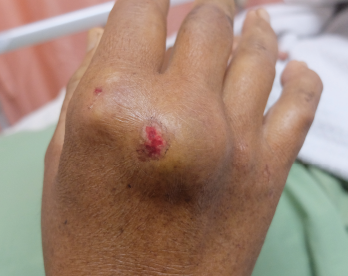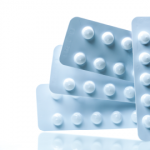
Gouty arthritis of the hand.
Casa nayafana / shutterstock.com
CHICAGO—The Gout and Hyperuricemia scientific session at the 2018 ACR/ARHP Annual Meeting opened with a talk by Tony R. Merriman, PhD, a research professor at the University of Otago, New Zealand. His talk focused on molecular epidemiology, with an emphasis on the interactions between genes and environmental exposures, and their contributions to gout.
Dr. Merriman began by explaining that although hyperuricemia (HU, the production of uric acid or urate from the liver) is the essence of gout, actual gout flares occur when the immune system responds to the uric acid crystals. HU can be exacerbated by under-excretion of urate through the kidney and gut, and is caused by a combination of inherited genetic variants and environmental exposures. Although the genetic contributors to HU are well understood, the genetic components of the immune response to gout crystals remain less well understood.
Researchers have found erosions from tophi on ancient bones in Pacific archeological sites that suggest the primitive cultures of Polynesia had a crude gout prevalence of 6%.1 Polynesians are inherently hyperuricemic and tolerate HU well when they follow their native lifestyle. As Polynesians migrated to New Zealand and encountered a Western lifestyle, however, they experienced an increased prevalence of gout, which occurred absent a substantive change in uric acid levels.2,3
Although Polynesians have a urate threshold impervious to the environment, Europeans do not. Europeans and others demonstrate a more pronounced increase in urate and gout with migration and time. This distinction means the Polynesian data cannot be used as general population-based data.
Dr. Merriman then discussed the role of diet as a cause of gout in European men.4 He explained that although the European diet has changed significantly from the 1950s until now, it appears diet alone doesn’t explain the extreme increase in urate levels. However, diet may explain gout flares. Approximately 75% of patients report dietary triggers for their flares, the most common of which are alcohol and red meat. Moreover, a case-controlled crossover study revealed that purine-rich foods can cause gout.5
The data in Polynesia and Europe are thus consistent with the finding that although diet contributes to gout, it is less of a factor in HU. In fact, urate levels appear to be 60% heritable.6 Genome-wide association studies (GWAS) have examined many millions of common genetic variants to determine which regions of the genome associate with HU or gout. These studies revealed existing and new urate transporters and, in particular, identified the gene encoding Solute Carrier Family 2 Member 9 (SLC2A9), a re-uptake transporter for urea, and the gene encoding ATP Binding Cassette Subfamily G Member 2 (ABCG2), a urea secretory transporter in the gut.7,8 A more detailed analysis of the GWAS data, however, has revealed many loci that do not contain obvious transporters, and scientists do not yet know the biology behind most of these loci.9
As Polynesians migrated to New Zealand & encountered a Western lifestyle, … they experienced an increased prevalence of gout.
Leo A.B. Joosten, PhD, professor of mechanisms of inflammatory diseases at Radboud University, Nijmegen in The Netherlands, then took the stage to describe a functional genomics approach to understanding variation in the effect of diet and the microbiome on uric acid and gout. His work is part of the ’omics revolution that has brought with it many tools to generate big data. Now that the big data have been collected, he explained, the most important step is to synthesize the data. The Human Functional Genomics Projects (HFGP) includes the 500 functional genomics project (500FG) and was designed to do just this. Its questionnaire provides a very detailed analysis of the phenotype and combines this data with blood tests, transcriptome and metabolome to correlate the phenotype with circulating levels of hormones, immunoglobulins, interleukin (IL)-1, IL-6 and other factors.
When Dr. Joosten and his colleagues examined the genetic architecture of cytokine responses of peripheral blood mononuclear cells (PBMCs) in 500 healthy subjects, they found 17 independent loci influence cytokine production.10 They identified the toll-like receptor (TLR) 1/6/10 locus, which has previously been shown to be a risk factor for many diseases.
When they examined the relationship between cytokine response and the microbiome, they were able to characterize inter-individual variability in cytokine response to pathogenic stimulation of cells from healthy individuals that reflected differences in their microbiome.11 This effect, however, only represented at maximum 10% of the interindividual variability, suggesting genes have a much bigger effect on cytokine response than does the microbiome.
Researchers have found, however, that the microbiome does associate with HU and cardiovascular disease (CVD) status, so in the future Dr. Joosten plans to examine the association between HU, hyper-responsiveness of innate immune cells, genetics and the microbiome.
Lara C. Pullen, PhD, is a medical writer based in the Chicago area.
References
- Rose BS. Gout in Maoris. Semin Arthritis Rheum. 1975 Nov;5(2):121–145.
- Prior IA, Welby TJ, Ostbye T, et al. Migration and gout: the Tokelau Island migrant study. Br Med J (Clin Res Ed). 1987 Aug 22;295(6596):457–461.
- Wigley RD, Manahan L, Caragay R, et al. Observations on rheumatic disease in Polynesia and the Philippines. J Rheumatol Suppl. 1983 Nov;10:37–40.
- Manara M, Carrara G, Scirè CA, et al. Lifestyle and dietary habits of patients with gout followed in rheumatology settings. Reumatismo. 2015 Dec 23;67(4):138–148.
- Zhang Y, Chen C, Choi H, et al. Purine-rich foods intake and recurrent gout attacks. Ann Rheum Dis. 2012 Sep; 71(9):1448–1453.
- Reginato AM, Mount DB, Yang I, et al. The genetics of hyperuricaemia and gout. Nat Rev Rheumatol. 2012 Oct;8(10):610–621.
- Tin A, Li Y, Brody JA, et al. Large-scale whole-exome sequencing association studies identify rare functional variants influencing serum urate levels. Nat Commun. 2018 Oct 12;9(1):4228.
- Chen CJ, Tseng CC, Yen JH, et al. ABCG2 contributes to the development of gout and hyperuricemia in a genome-wide association study. Sci Rep. 2018 Feb 16;8(1):3137.
- Major TJ, Dalbeth N, Stahl EA, et al. An update on the genetics of hyperuricaemia and gout. Nat Rev Rheumatol. 2018 Jun;14(6):341–353.
- Tunjungputri RN, Li Y, de Groot PG, et al. The inter-relationship of platelets with interleukin-1β-mediated inflammation in humans. Thromb Haemost. 2018 Dec;118(12):2112–2125.
- Bakker OB, Aguirre-Gamboa R, Sanna S, et al. Integration of multi-omics data and deep phenotyping enables prediction of cytokine responses. Nat Immunol. 2018 Jul;19(7):776–786.


